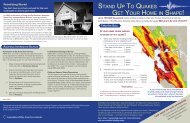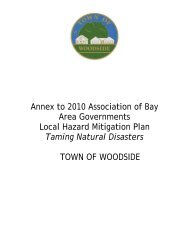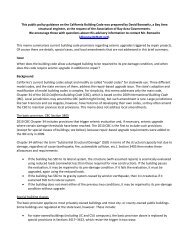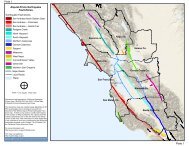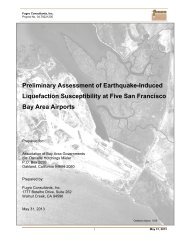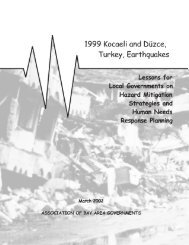Safe Enough to Stay - ABAG Earthquake and Hazards Program
Safe Enough to Stay - ABAG Earthquake and Hazards Program
Safe Enough to Stay - ABAG Earthquake and Hazards Program
- No tags were found...
You also want an ePaper? Increase the reach of your titles
YUMPU automatically turns print PDFs into web optimized ePapers that Google loves.
<strong>Safe</strong> <strong>Enough</strong> <strong>to</strong> <strong>Stay</strong>Section I RecommendationsSan Francisco faces a clear problem. An estimated 25 percent ofhousing units might not be usable after a future expected earthquake.However, our analysis indicates that if as little as 5 percent of thecity’s housing s<strong>to</strong>ck is out of commission after a disaster, the citycould have a slow <strong>and</strong> arduous recovery. We recommend five stepsSan Francisco should take <strong>to</strong> improve its housing s<strong>to</strong>ck <strong>and</strong> plan fordisplaced residents.1. Adopt recovery targets for the housing sec<strong>to</strong>r asa whole, based on what is necessary for citywideresilience in a large but expected earthquake.SPUR has recommended that 95 percent shelter in place is theappropriate goal for San Francisco. This target should be adopted bythe City <strong>and</strong> County of San Francisco, either in the Community <strong>Safe</strong>tyElement of the General Plan or as a st<strong>and</strong>-alone piece of legislationadopted by the Board of Supervisors. The city should set a 30-yeartime frame <strong>to</strong> reach this goal, mirroring the established 30-year timeframe <strong>to</strong> implement the CAPSS recommendations.2. Implement the Community Action Plan for Seismic<strong>Safe</strong>ty (CAPSS) recommended m<strong>and</strong>a<strong>to</strong>ry softs<strong>to</strong>ryretrofit program.Estimated increase in shelter-in-place capacity: 5 <strong>to</strong> 6 percent 28As SPUR noted in its 2009 Resilient City series of report, the singlemost important step San Francisco can take <strong>to</strong> increase its resilienceis <strong>to</strong> adopt a m<strong>and</strong>a<strong>to</strong>ry retrofit program for wood-frame soft-s<strong>to</strong>rybuildings with three s<strong>to</strong>ries or more <strong>and</strong> five units or more.The Department of Building Inspection recently completed a studyas part of CAPSS that recommends a m<strong>and</strong>a<strong>to</strong>ry evaluation of thesebuildings, followed by m<strong>and</strong>a<strong>to</strong>ry retrofit for those buildings thatare found <strong>to</strong> have a soft-s<strong>to</strong>ry condition. If all wood-frame soft-s<strong>to</strong>ryresidences in the city with three or more s<strong>to</strong>ries <strong>and</strong> five or moreresidential units were seismically retrofitted, we estimate that 80percent of city residents would be able <strong>to</strong> shelter in place after amagnitude 7.2 San Andreas earthquake. 29 This represents a 5 <strong>to</strong>6 percent improvement over where the city st<strong>and</strong>s <strong>to</strong>day. SPURrecommends implementing the CAPSS recommendations as soon aspossible.3. Develop a soft-s<strong>to</strong>ry retrofit program for smallersoft-s<strong>to</strong>ry buildings.Estimated increase in shelter-in-place capacity: 6 <strong>to</strong> 9 percentWhile CAPSS focused on wood-frame soft-s<strong>to</strong>ry buildings of threes<strong>to</strong>ries or more with five units or more, smaller wood-frame soft-s<strong>to</strong>rybuildings also pose a major challenge <strong>to</strong> San Francisco’s resilience.These buildings occur in large numbers in the Sunset <strong>and</strong> Richmonddistricts, both of which are highly vulnerable <strong>to</strong> the expectedearthquake. We recommend developing a retrofit program for thesebuildings as well. Wood-frame soft-s<strong>to</strong>ry buildings with three <strong>and</strong>four units would be responsible for about one-third of all unusablehousing units after the expected earthquake. Wood-frame soft-s<strong>to</strong>rysingle-family houses <strong>and</strong> duplexes would account for another 20percent of unusable units.4. Develop retrofit programs for other vulnerablehousing types that impact San Francisco’sresilience <strong>and</strong> also have the potential <strong>to</strong> severelyinjure or kill people.Estimated increase in shelter-in-place capacity: 1 percentThere are a number of building types used for housing, such asnon-ductile concrete buildings <strong>and</strong> unreinforced masonry buildings,that will not be able <strong>to</strong> serve as shelter-in-place housing <strong>and</strong> alsohave the potential <strong>to</strong> suffer significant damage, causing injury <strong>and</strong>loss of life. Non-ductile concrete buildings are found in a variety ofdifferent neighborhoods, everywhere from relatively wealthy parts ofRussian Hill <strong>to</strong> the Tenderloin <strong>and</strong> China<strong>to</strong>wn. However, we do notcurrently know how many residential non-ductile concrete buildingsexist in the city or where they are located. The city should begin bydeveloping a reliable inven<strong>to</strong>ry of these buildings. Some non-ductileconcrete buildings can be very difficult <strong>and</strong> expensive <strong>to</strong> retrofit, butthey nonetheless require attention because of the harm they couldcause. Due <strong>to</strong> the complexity of some of these retrofits, it might makesense <strong>to</strong> start with evaluating these buildings <strong>and</strong> notifying owners<strong>and</strong> occupants of the findings.28 These estimates were developed using available data <strong>and</strong> engineeringassumptions. Data sources include CAPSS ATC 52-1, CAPSS ATC 52-3, theDepartment of Building Inspection Housing Database <strong>and</strong> the 2000 U.S.Census, among others. Multiple sources were used <strong>to</strong> estimate the number ofunits by structure type <strong>and</strong> size, <strong>and</strong> these sometimes presented conflictinginformation. Because conservative assumptions were used <strong>to</strong> estimate retrofiteffectiveness, it is possible that retrofits may be more effective than stated aboveat improving the number of units available for shelter in place after the expectedearthquake.29 This assumes a high st<strong>and</strong>ard of retrofit, referred <strong>to</strong> as Retrofit Scheme 3 inthe CAPSS report Here Today, Here Tomorrow: <strong>Earthquake</strong> <strong>Safe</strong>ty for Soft-S<strong>to</strong>ryBuildings (ATC 52-3). There are 4,400 wood-frame buildings with three or mores<strong>to</strong>ries <strong>and</strong> five or more units in San Francisco, an unknown number of whichhave a soft-s<strong>to</strong>ry condition.18 SPUR Report > January 2012



